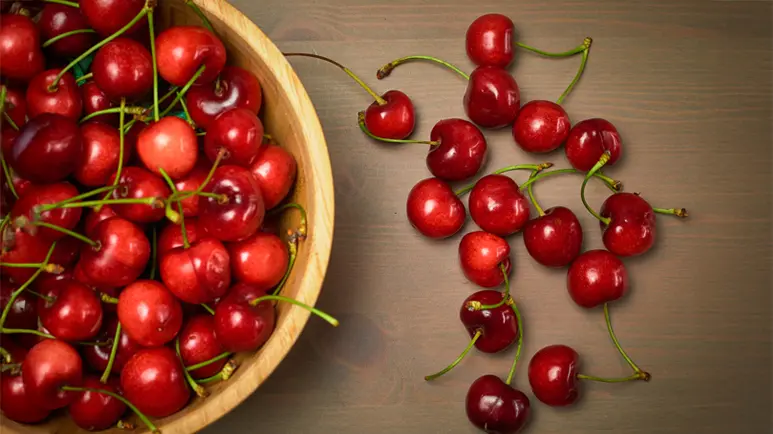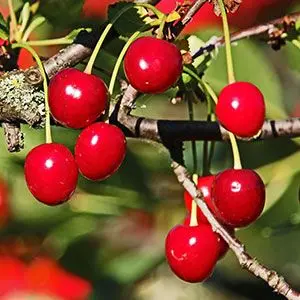This Little Fruit Packs a Big Punch for Your Pet's Health
These little, polyphenol-rich fruits may help support your pet's health in various ways, all while being a tasty treat! Have you tried offering them to your pet?

STORY AT-A-GLANCE
- Sweet cherries contain polyphenols to help support pet health in various ways, such as helping manage inflammation, promote gut health and reduce the risk of cancer
- Sweet cherries contain lutein and zeaxanthin, carotenoids that accumulate in the retina and may help promote eye health
- The vitamin C in cherries is essential in helping promote proper immune function, as well as serving as a cofactor for numerous enzymes
- When feeding sweet cherries to your pet, moderation is required because of their sugar content
- Be sure to remove cherry pits before feeding to your pet, as they can be a potential choking hazard
Editor's Note: This article is a reprint. It was originally published June 19, 2023.
Cherries are the 13th most popular fruit consumed in the U.S.1 They’re used in tarts and pies, or you may have eaten them as toppings for ice cream. But what about your four-legged companion? As it turns out, cherries can be used as an occasional treat for your pet thanks to their delectable flavor.
There are two main types of cherries: sweet cherries (Prunus avium) and sour or tart cherries (Prunus cerasus).2 This article will focus on the health benefits of the Prunus avium species and how to properly serve them to your pet.
What Are Sweet Cherries?
Juicy, delicious and perfect for snacking on their own, sweet cherries are more popular and widely available than their sour counterpart.3 They’re also a good choice for pets because they’re more palatable, especially to dogs, as they have developed a fondness for sweet flavors, just like humans.4 Well-known varieties that fall under the sweet cherry family include:5
- Bing cherries
- Benton cherries
- Chelan cherries
- Attika cherries
- Santina cherries
- Tieton cherries
- Skeena cherries
- Cowiche cherries
- Regina cherries
- Lapins cherries
- Kiona cherries
- Selah cherries
But more than their scrumptious flavor, what’s impressive about sweet cherries is their diverse nutritional profile, as you’ll learn below.
Did You Know?

Aside from providing sustenance, cherry trees have other uses. Their wood is used to make furniture and musical instruments.6 Small- to medium-sized sweet cherry trees can also be used as garden ornaments.7
Sweet Cherries Are Rich in Polyphenols
“Cherries can be a nutritious treat for your pet thanks to their assorted bioactive compounds, including anthocyanins such as delphinidin, pelargonidin, cyanidin and malvidin — all of which belong under the polyphenol category.”8
Delphinidin is a purple-colored plant pigment9 with angiogenic properties, which may help lower the risk for cancer.10 In addition, anthocyanins may be helpful in promoting gut health. A study published in Frontiers in Nutrition suggested that consumption of anthocyanins, such as delphinidin, may help proliferate beneficial strains of bacteria in the gut, such as Bifidobacterium and Lactobacillus, while simultaneously helping reduce pathogenic strains.11
Meanwhile, pelargonidin was shown to have protective effects against neuronal apoptosis and the memory process, based on a mice study published in 2021.12 In another study, pelargonidin was noted to have a possible anticancer effect, as observed in tested mice.13
In the case of cyanidin, a study from 2018 observed its anti-inflammatory effects on collagen-induced arthritis in test mice. Results indicated that administration of cyanidin significantly helped reduce the effects of arthritis, specifically by inhibiting the activation of the NF-KB and MAPK signaling pathway.14
Other Beneficial Nutrients Found in Sweet Cherries
Sweet cherries offer vitamin C as well as lutein and zeaxanthin,15 which may support your pet’s health in various ways. In the case of vitamin C, a single sweet cherry can provide half a milligram of it.16 Vitamin C is essential in helping promote proper immune function, as well as serving as a cofactor for numerous enzymes.17 This antioxidant also promotes skin health and wound healing, as it plays a role in collagen synthesis.18
Meanwhile, lutein and zeaxanthin are two carotenoids that work together to help promote eye health. In fact, research has shown that they are the only carotenoids that accumulate in the retina.19 In a single sweet cherry, your pet can obtain 6.97 micrograms of both right away.20 Research has shown that lutein and zeaxanthin, when administrated to dogs, led to improvement in retinal function and helped lower decline of refractive errors.21
Sweet Cherries Fun Fact

It’s believed that sweet cherries were brought to Europe by migrating birds. Records show these sweet fruits originally grew in lands between the Black and Caspian seas.22
Sustainability and Environmental Impact of Growing Cherries
The Environmental Working Group (EWG) places cherries at the 10th spot of their Dirty Dozen list.23 This means that most conventionally grown cherries today are sprayed with pesticides. If possible, look for spray-free, certified organic sweet cherries to help lessen exposure to toxic pesticides. If that’s not possible, you can wash cherries in water mixed with baking soda, preferably a teaspoon for every cup. Soak the cherries in this mixture for 15 minutes, then transfer to a colander and rinse in water for a minute.24
Grown sustainably, cherry trees have minimal negative impact on the environment, including a low water footprint. Furthermore, once mature, the trees can sequester large amounts of carbon and fertilize the soil. Many of the downsides associated with cherry farming are connected to high usage of pesticides and the amount of plastic packaging used during processing.25
Top Producers of Sweet Cherries in the US

The West Coast produces the majority of cherries in America. Market research indicates that Washington, Oregon and California account for almost 90% of the cherries produced nationwide.26

Feeding Sweet Cherries to Your Pet
Misinformation about many healthy fruits, vegetables, nuts and seeds abounds on the internet. This is because websites have labeled all risks (such as the risk of overconsumption causing gastrointestinal issues, or choking on too large of pieces or pits) as "toxicities," which isn't true but has managed to confuse millions of pet lovers, nonetheless.
For example, many sites claim that cherries (as well as peaches and plums) are toxic to pets because the pits contain cyanide, and they pose a choking hazard if they’re not removed (this is also true for humans). However, the flesh of cherries is not toxic to any animals. A single cherry pit also does not contain sufficient amounts of cyanide to poison pets.27
The risks involving cherry pits, whether it’s about choking or cyanide-related, can be avoided by exercising common sense when feeding cherries to pets — that is, always remove the pits and slice the cherry into small pieces that your pet can safely chew, if needed. Be sure to also keep the leaves and stems out of your pet’s reach.
You can feed your pet a few fresh cherries per 20 pounds of body weight as meal toppers or as treats to keep sugar consumption minimal. Keep treats to less than 10% of your pet’s daily caloric intake, while the remaining calories should come from minimally processed, nutritionally balanced, species-appropriate meals.
As for the variety of sweet cherries to feed your pet, any may be viable. Just make sure they’re properly washed, and the stems and pits are removed before consumption.
Sources and References
- 1 International Fresh Produce Association, Top 20 Fruits and Vegetables Sold in the U.S.
- 2 Washington State University, Varieties - Cherry
- 3 Pepper's Home and Garden, Sweet Cherries vs. Sour Cherries
- 4 American Kennel Club, March 19, 2018
- 5 Culinary Depot, Different Types of Cherries (Archived)
- 6 European Atlas of Forest Tree Species, Tree Species, Page 140
- 7 Missouri Botanical Garden, Prunus Avium
- 8 Ther Adv Musculoskel Dis, 2019, Vol. 11: 1–16, Cherries
- 9 Front Nutr. 2022; 9: 746881., Introduction
- 10 Carcinogenesis, Volume 27, Issue 5, May 2006, Pages 989–996, Abstract
- 11 Front Nutr. 2022; 9: 746881., Metabolic Characteristics of Dp and Its Effect on Gut Microbiota
- 12 Avicenna J Phytomed. 2021 Jul-Aug; 11(4): 407–416, Abstract
- 13 Chem Biol Interact. 2019 Aug 25; 309: 108701., Abstract
- 14 Clin Exp Pharmacol Physiol. 2018 Oct;45(10):1038-1045, Abstract
- 15 Molecules. 2010 Oct; 15(10): 6993–7005, Table 1
- 16,20 USDA FoodData Central, Cherries, Sweet, Dark Red, Raw
- 17 Free Radic Biol Med. 2011 Sep 1; 51(5): 1000–1013, Vitamin C
- 18 Int Wound J. 2015 Aug; 13(4): 572–584, Abstract
- 19 Nutrients. 2022 Feb; 14(4): 827, Abstract
- 21 J Nutr Sci. 2016; 5: e18, Abstract
- 22 Chinchiolo, February 1, 2022
- 23 EWG, The 2024 Dirty Dozen™
- 24 Masterclass, January 7, 2022
- 25 Impactful Ninja, The Environmental Impact of Cherries: From Farm to Table
- 26 Ag MRC, April 2024
- 27 American Kennel Club, August 14, 2024











